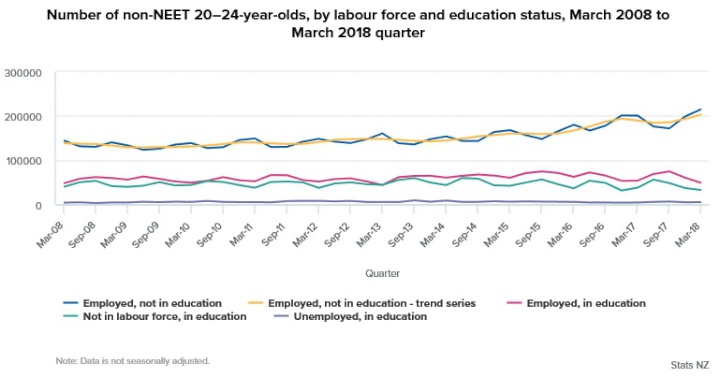Young people choose to earn, not learn
26 June 2018
People in their early twenties are more likely to be earning and less likely to be learning, Stats NZ said today.
Since 2004 (when the series began), 20–24-year-olds have been the key contributors to the number of young men and women not in employment, education, or training (NEET).
This story looks at the six-year period to the March 2018 quarter, when 15.2 percent of 20–24-year-olds were not earning or learning, down from a peak of 19.7 percent in the March 2012 quarter.
Over that period, the proportion of working 20–24-year-olds has grown from 65.2 percent to 74.1 percent. This was the largest increase for any age group. Men and women contributed to the rise nearly equally – up 32,500 and 31,900, respectively. For both men and women, the key contribution to employment growth came from those who were working and not in education. The number of working women not in education increased by 37,600, while men saw a smaller rise (up 29,200).

While the population of 20–24-year-olds has increased over the last six years (up 49,900 to 357,700), the number of people in this age group who are not in the labour force (NILF) has fallen to 67,100 (down 6,400). This fall was largely driven by women (down 11,300).
In the March 2012 quarter, 17,500 (11.4 percent) of 20–24-year-old women were not in the labour force or education due to caregiving. Six years on, this number has dropped to 10,400 (6.1 percent).
“This drop is in line with a fall in birth rates since 2008,” labour market statistics manager Sean Broughton said. “This fall in birth rates mainly reflects young women aged 15–29 years, whose birth rates are now at a record low.”
Fewer 20–24-year-olds in education
Since the March 2012 quarter, the proportion of people aged 20–24 years who were in education, regardless of their labour force status, has decreased from 31.8 percent to 24.3 percent. This was the lowest point since the series began. However, the proportion of 20–24-year-olds with no qualifications has also fallen from 14.1 percent to 8.2 percent.
Over the last six years, there has been a large increase in the proportion of 20–24-year-olds with a school qualification as their highest qualification. In the March 2018 quarter, nearly half (48.2 percent) of all 20–24-year-olds were in this position (up from 39.6 percent in the March 2012 quarter). People in their early twenties were also less likely to have a post-school qualification (41.6 percent, compared with 45.1 percent), but more likely to have a bachelor’s degree or above (20.5 percent, compared with 12.8 percent).
The most recent data shows 66,800 more 20–24-year-olds were working and not in education than in the March 2012 quarter. Two-thirds of the increase came from people with a school qualification as their highest qualification, while two-fifths came from those with a bachelor’s degree.
Compared with six years ago, those with a school qualification as their highest level of attainment were less likely to be in education – 35.5 percent, compared with 50.1 percent. This is the lowest point since the series began. However, they were more likely to be working – 70.8 percent (up from 61.6 percent).
“This data suggests that many young people are heading straight into the workforce after completing their school education, rather than continuing with further study,” Mr Broughton said. “Almost all of the increase in the number of working people whose highest qualification was achieved at school was from those who were working, but not in education.”
20–24-year olds with a bachelor’s degree as their highest qualification were also more likely to be working (83.9 percent) and less likely to be in education (16.7 percent) or NEET (10.0 percent) than in 2012. This group saw a particularly large rise in the percentage of those employed and not in education (72.6 percent, up from 58.4 percent).
Employment growth
Almost one-third of working 20–24-year-olds moved into professional occupations (eg roles such as teachers, architects, or nurses). Other growth occupations were sales workers, managers, and community and personal service workers, including both hospitality workers and carers and aides. For young men, there was also growth in the number of technicians and trade workers.
The retail trade and accommodation industry accounted for about one-quarter of the increase in working 20–24-year-olds, particularly for women. The professional, scientific, technical, administration, and support services industry saw substantial growth for both men and women, although this is a very broad category encompassing a wide range of different roles.
Amongst young women, there were also large increases in the education and training, and health care and social assistance industries.
For more information
about these statistics:
• Visit Young people choose to earn, not
learn
Ends


 Business Canterbury: Urges Council To Cut Costs, Not Ambition For City
Business Canterbury: Urges Council To Cut Costs, Not Ambition For City Wellington Airport: On Track For Net Zero Emissions By 2028
Wellington Airport: On Track For Net Zero Emissions By 2028 Landcare Research: ANZAC Gall Fly Release Promises Natural Solution To Weed Threat
Landcare Research: ANZAC Gall Fly Release Promises Natural Solution To Weed Threat NZ Anti-Vivisection Society: Auckland Rat Lovers Unite!
NZ Anti-Vivisection Society: Auckland Rat Lovers Unite! University of Canterbury: $1.35 Million Grant To Study Lion-like Jumping Spiders
University of Canterbury: $1.35 Million Grant To Study Lion-like Jumping Spiders Federated Farmers: Government Ends War On Farming
Federated Farmers: Government Ends War On Farming



